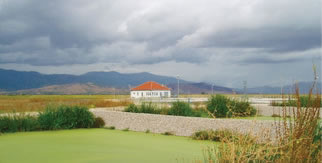
Environmental Science and Engineering
Organic Wastewater Compounds, Pharmaceuticals, and Coliphage in Groundwater Receiving Discharge from Onsite Wastewater Treatment Systems Near La Pine, Oregon: Occurrence and Implications for Transport
Publication Date: April 2005
Cooperating Institution: Oregon Department of Environmental Quality
Principal Investigator: Rodney Weick
Project Budget: $299,281
Project Identifier: WU-HT-03-05
DESCRIPTION
This research will expand upon the scope of work in the La Pine National Community Decentralized Wastewater Demonstration Project to include research on coliphage attenuation during on-site wastewater treatment, and on subsequent transport in ground water. This work will also be complemented by evaluating the suitability of common wastewater compounds as tracers of coliphage transport. Coliphage are viruses that infect and replicate in coliform bacteria, and are found in high concentrations in wastewater. Wastewater compounds of interest will be a suite of 67 compounds typically found in domestic and industrial wastewater, including caffeine, cholesterol, menthol, camphor, cotinine (a nicotine metabolite), detergent metabolites, antimicrobial agents, disinfectants, antioxidants, and compounds originating from deodorants and fragrances. The research will consist of two components: (1) attenuation of coliphage in traditional and innovative onsite wastewater systems will be measured to provide information about the efficiency of coliphage removal during treatment of wastewater, (2) ground water contaminated with plumes of wastewater will be sampled at various points for coliphage and wastewater compounds to determine transport parameters for these analytes and to determine the suitability of wastewater compounds as surrogates for coliphage transport.
This work will take the science of virus transport to a new level. Up until now, most research to advance the understanding of virus transport in ground water has (1) taken the form of laboratory column experiments using coliphage, (2) taken place in carefully constrained field settings with injected laboratory-grown coliphage, and (3) focused on transport of viruses from la nd application of municipal wastewater and sludge. Little work has been done to estimate field-based, natural-gradient transport parameters for viruses originating from distributed sources such as on-site wastewater systems. Yet hydrologists and water resource managers increasingly recognize that predictive ground-water transport models can be useful research and management tools. These transport models require transport parameters, including transport parameters for viruses from field studies in which transport mechanisms are representative of common sources such as on-site wastewater systems. The shallow water table and existing research infrastructure in the La Pine NDP study area presents an ideal setting for studying transport of on-site wastewater-derived coliphage under natural- gradient conditions. Furthermore, the existing infrastructure of the La Pine NDP study can be used to test the ability of innovative on-site wastewater systems to remove coliphage during wastewater treatment, and to test the usefulness of wastewater compounds as tracers of coliphage occurrence and transport.

